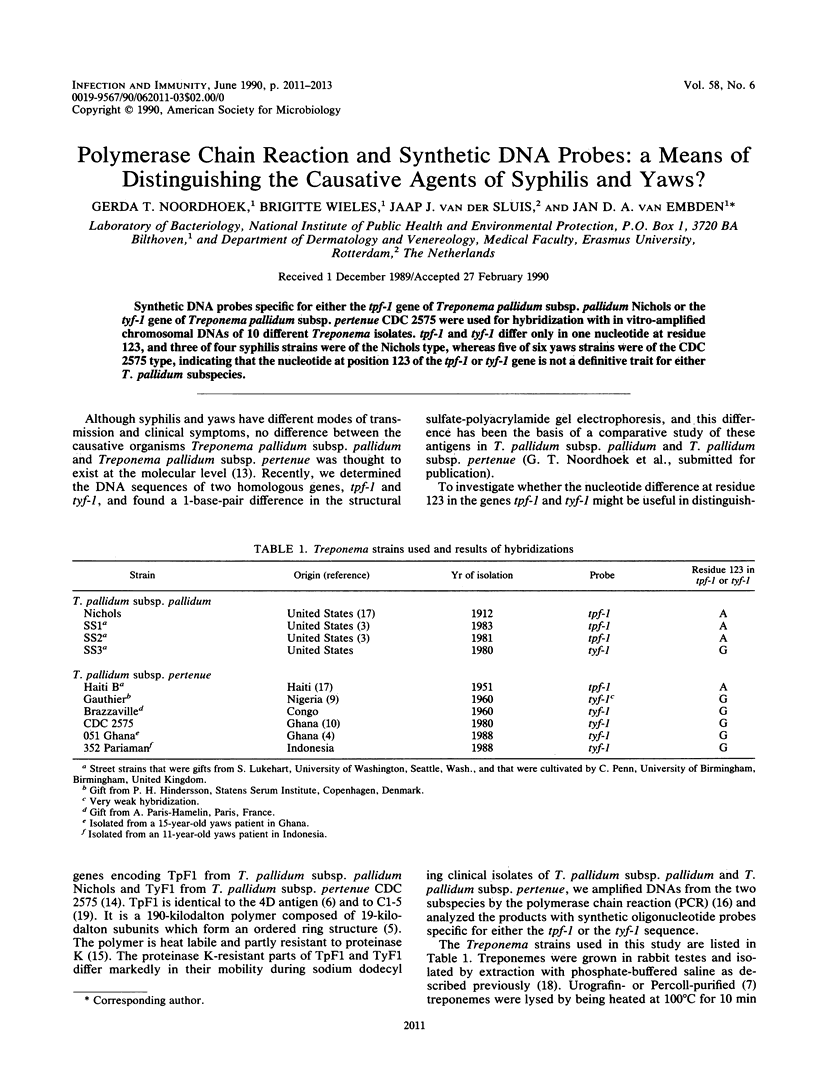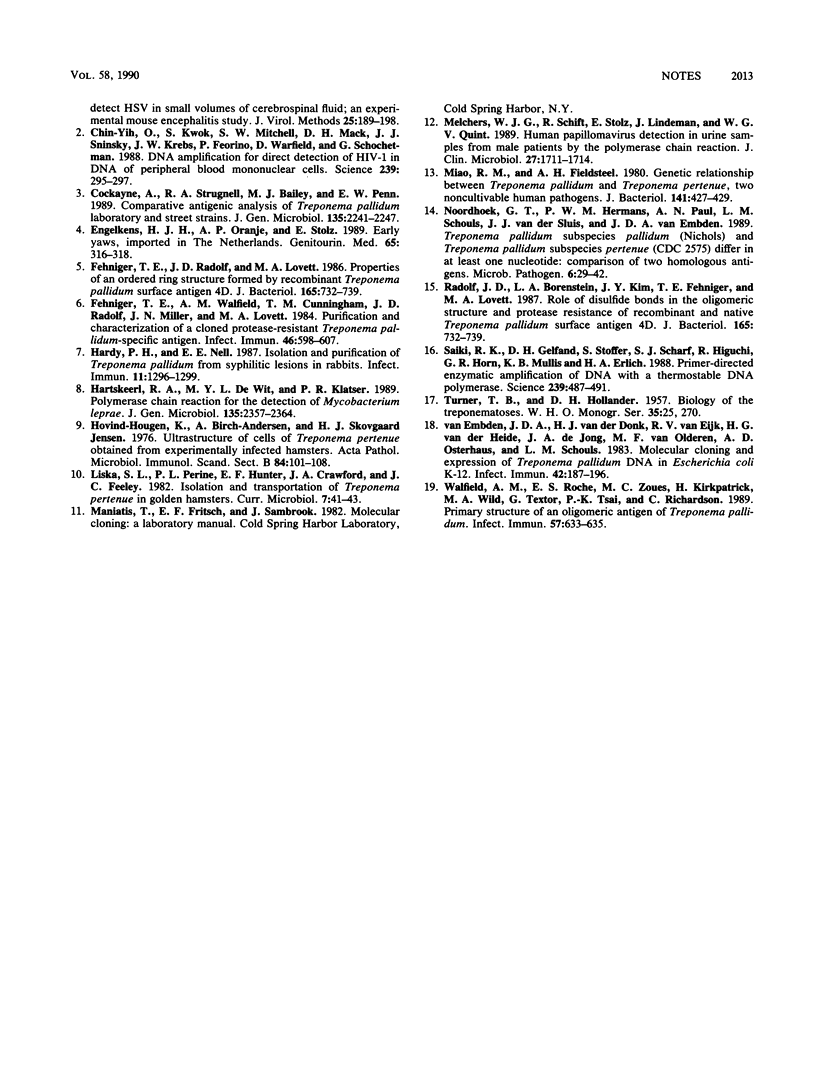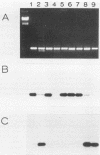Abstract
Synthetic DNA probes specific for either the tpf-1 gene of Treponema pallidum subsp. pallidum Nichols or the tyf-1 gene of Treponema pallidum subsp. pertenue CDC 2575 were used for hybridization with in vitro-amplified chromosomal DNAs of 10 different Treponema isolates. tpf-1 and tyf-1 differ only in one nucleotide at residue 123, and three of four syphilis strains were of the Nichols type, whereas five of six yaws strains were of the CDC 2575 type, indicating that the nucleotide at position 123 of the tpf-1 or tyf-1 gene is not a definitive trait for either T. pallidum subspecies.
Full text
PDF


Images in this article
Selected References
These references are in PubMed. This may not be the complete list of references from this article.
- Cockayne A., Strugnell R. A., Bailey M. J., Penn C. W. Comparative antigenic analysis of Treponema pallidum laboratory and street strains. J Gen Microbiol. 1989 Aug;135(8):2241–2247. doi: 10.1099/00221287-135-8-2241. [DOI] [PubMed] [Google Scholar]
- Engelkens H. J., Oranje A. P., Stolz E. Early yaws, imported in The Netherlands. Genitourin Med. 1989 Oct;65(5):316–318. doi: 10.1136/sti.65.5.316. [DOI] [PMC free article] [PubMed] [Google Scholar]
- Fehniger T. E., Radolf J. D., Lovett M. A. Properties of an ordered ring structure formed by recombinant Treponema pallidum surface antigen 4D. J Bacteriol. 1986 Mar;165(3):732–739. doi: 10.1128/jb.165.3.732-739.1986. [DOI] [PMC free article] [PubMed] [Google Scholar]
- Fehniger T. E., Walfield A. M., Cunningham T. M., Radolf J. D., Miller J. N., Lovett M. A. Purification and characterization of a cloned protease-resistant Treponema pallidum-specific antigen. Infect Immun. 1984 Nov;46(2):598–607. doi: 10.1128/iai.46.2.598-607.1984. [DOI] [PMC free article] [PubMed] [Google Scholar]
- Hardy P. H., Jr, Nell E. E. Isolation and purification of Treponema pallidum from syphilitic lesions in rabbits. Infect Immun. 1975 Jun;11(6):1296–1299. doi: 10.1128/iai.11.6.1296-1299.1975. [DOI] [PMC free article] [PubMed] [Google Scholar]
- Hartskeerl R. A., de Wit M. Y., Klatser P. R. Polymerase chain reaction for the detection of Mycobacterium leprae. J Gen Microbiol. 1989 Sep;135(9):2357–2364. doi: 10.1099/00221287-135-9-2357. [DOI] [PubMed] [Google Scholar]
- Hovind-Hougen K., Birch-Andersen A., Jensen H. J. Ultrastructure of cells of Treponema pertenue obtained from experimentally infected hamsters. Acta Pathol Microbiol Scand B. 1976 Apr;84(2):101–108. doi: 10.1111/j.1699-0463.1976.tb01909.x. [DOI] [PubMed] [Google Scholar]
- Melchers W. J., Schift R., Stolz E., Lindeman J., Quint W. G. Human papillomavirus detection in urine samples from male patients by the polymerase chain reaction. J Clin Microbiol. 1989 Aug;27(8):1711–1714. doi: 10.1128/jcm.27.8.1711-1714.1989. [DOI] [PMC free article] [PubMed] [Google Scholar]
- Miao R. M., Fieldsteel A. H. Genetic relationship between Treponema pallidum and Treponema pertenue, two noncultivable human pathogens. J Bacteriol. 1980 Jan;141(1):427–429. doi: 10.1128/jb.141.1.427-429.1980. [DOI] [PMC free article] [PubMed] [Google Scholar]
- Noordhoek G. T., Hermans P. W., Paul A. N., Schouls L. M., van der Sluis J. J., van Embden J. D. Treponema pallidum subspecies pallidum (Nichols) and Treponema pallidum subspecies pertenue (CDC 2575) differ in at least one nucleotide: comparison of two homologous antigens. Microb Pathog. 1989 Jan;6(1):29–42. doi: 10.1016/0882-4010(89)90005-3. [DOI] [PubMed] [Google Scholar]
- Ou C. Y., Kwok S., Mitchell S. W., Mack D. H., Sninsky J. J., Krebs J. W., Feorino P., Warfield D., Schochetman G. DNA amplification for direct detection of HIV-1 in DNA of peripheral blood mononuclear cells. Science. 1988 Jan 15;239(4837):295–297. doi: 10.1126/science.3336784. [DOI] [PubMed] [Google Scholar]
- Saiki R. K., Gelfand D. H., Stoffel S., Scharf S. J., Higuchi R., Horn G. T., Mullis K. B., Erlich H. A. Primer-directed enzymatic amplification of DNA with a thermostable DNA polymerase. Science. 1988 Jan 29;239(4839):487–491. doi: 10.1126/science.2448875. [DOI] [PubMed] [Google Scholar]
- Walfield A. M., Roche E. S., Zounes M. C., Kirkpatrick H., Wild M. A., Textor G., Tsai P. K., Richardson C. Primary structure of an oligomeric antigen of Treponema pallidum. Infect Immun. 1989 Feb;57(2):633–635. doi: 10.1128/iai.57.2.633-635.1989. [DOI] [PMC free article] [PubMed] [Google Scholar]
- van Embden J. D., van der Donk H. J., van Eijk R. V., van der Heide H. G., de Jong J. A., van Olderen M. F., Osterhaus A. B., Schouls L. M. Molecular cloning and expression of Treponema pallidum DNA in Escherichia coli K-12. Infect Immun. 1983 Oct;42(1):187–196. doi: 10.1128/iai.42.1.187-196.1983. [DOI] [PMC free article] [PubMed] [Google Scholar]



